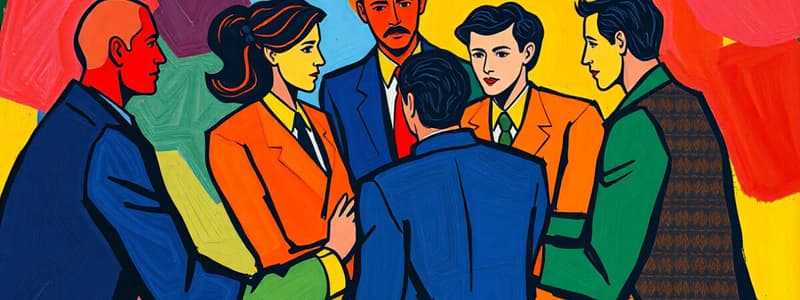Podcast
Questions and Answers
What distinguishes self-managed teams from problem-solving teams?
What distinguishes self-managed teams from problem-solving teams?
- Self-managed teams do not have direct daily supervision. (correct)
- Self-managed teams do not involve team members managing themselves.
- Problem-solving teams solely focus on feedback and recommendations.
- Problem-solving teams operate using specific technology.
What is a primary characteristic of a work team?
What is a primary characteristic of a work team?
- Members work intensely on a specific, common goal. (correct)
- Members act solely to share information.
- Members work independently on individual tasks.
- Members do not need complementary skills.
Which type of team is responsible for providing feedback to decision makers?
Which type of team is responsible for providing feedback to decision makers?
- Self-managed teams
- Advisory teams (correct)
- Work groups
- Virtual teams
What is the main focus of work groups compared to work teams?
What is the main focus of work groups compared to work teams?
What defines synergy in a work team context?
What defines synergy in a work team context?
Which of the following correctly describes virtual teams?
Which of the following correctly describes virtual teams?
How do work teams achieve superior performance levels?
How do work teams achieve superior performance levels?
Which of the following statements is true about self-managed teams?
Which of the following statements is true about self-managed teams?
What is the primary goal of a work team compared to a work group?
What is the primary goal of a work team compared to a work group?
At which stage of group development do team members begin to experience intragroup conflict?
At which stage of group development do team members begin to experience intragroup conflict?
Which of the following describes the 'norms' within a group?
Which of the following describes the 'norms' within a group?
Which factor is likely to increase the likelihood of social loafing in a group setting?
Which factor is likely to increase the likelihood of social loafing in a group setting?
What is true about smaller groups compared to larger groups?
What is true about smaller groups compared to larger groups?
What characterizes the 'performing' stage in Tuckman's model of group development?
What characterizes the 'performing' stage in Tuckman's model of group development?
In terms of group behaviour, what is conformity?
In terms of group behaviour, what is conformity?
Which type of roles are NOT considered in key aspects of group behaviour?
Which type of roles are NOT considered in key aspects of group behaviour?
What is a potential drawback of managing teams?
What is a potential drawback of managing teams?
Which factor should be considered when managing global teams?
Which factor should be considered when managing global teams?
What questions should be asked to determine if a team approach is suitable?
What questions should be asked to determine if a team approach is suitable?
In what situations are teams generally more beneficial?
In what situations are teams generally more beneficial?
What can increase communication problems in global teams?
What can increase communication problems in global teams?
What is a common reason for individuals to engage in free-riding within larger groups?
What is a common reason for individuals to engage in free-riding within larger groups?
Which of the following is NOT a characteristic of effective teams?
Which of the following is NOT a characteristic of effective teams?
Which team composition factor significantly impacts team effectiveness?
Which team composition factor significantly impacts team effectiveness?
What work design characteristic enhances team member motivation?
What work design characteristic enhances team member motivation?
Which contextual factor is least related to team performance?
Which contextual factor is least related to team performance?
Which of the following components is NOT part of the Team Effectiveness Model?
Which of the following components is NOT part of the Team Effectiveness Model?
Which of the following characteristics is least likely to lead to team effectiveness?
Which of the following characteristics is least likely to lead to team effectiveness?
Why is a climate of trust important for team effectiveness?
Why is a climate of trust important for team effectiveness?
What is the role of a common purpose in a team?
What is the role of a common purpose in a team?
How can low to moderate levels of task conflict be perceived?
How can low to moderate levels of task conflict be perceived?
What is a characteristic of relationship conflict?
What is a characteristic of relationship conflict?
Which of the following techniques can help minimize social loafing in teams?
Which of the following techniques can help minimize social loafing in teams?
What is one way managers can shape team behavior?
What is one way managers can shape team behavior?
Which of the following best describes team efficacy?
Which of the following best describes team efficacy?
Rewards in team settings serve what primary purpose?
Rewards in team settings serve what primary purpose?
Why is developing a Team Charter important?
Why is developing a Team Charter important?
What defines a formal group in an organization?
What defines a formal group in an organization?
Which of the following best describes informal groups?
Which of the following best describes informal groups?
Which type of team involves members from different departments with limited task interdependence?
Which type of team involves members from different departments with limited task interdependence?
What is a primary characteristic of problem-solving teams?
What is a primary characteristic of problem-solving teams?
What is the primary goal of both groups and teams in an organization?
What is the primary goal of both groups and teams in an organization?
What is one major difference between formal and informal groups?
What is one major difference between formal and informal groups?
Which statement accurately reflects the nature of teamwork?
Which statement accurately reflects the nature of teamwork?
Which of the following is a contemporary issue in managing teams?
Which of the following is a contemporary issue in managing teams?
Flashcards
Group
Group
Two or more interdependent individuals interacting to achieve shared goals.
Formal Group
Formal Group
A group structured by the organization for designated tasks or projects.
Informal Group
Informal Group
A naturally formed group based on social interactions and needs.
Cross-functional team
Cross-functional team
Signup and view all the flashcards
Problem-solving team
Problem-solving team
Signup and view all the flashcards
Work Group
Work Group
Signup and view all the flashcards
Work Teams
Work Teams
Signup and view all the flashcards
Group Development Stages
Group Development Stages
Signup and view all the flashcards
Self-managed teams
Self-managed teams
Signup and view all the flashcards
Advisory teams
Advisory teams
Signup and view all the flashcards
Virtual teams
Virtual teams
Signup and view all the flashcards
Synergy
Synergy
Signup and view all the flashcards
Accountability
Accountability
Signup and view all the flashcards
Complementary skills
Complementary skills
Signup and view all the flashcards
Social Loafing
Social Loafing
Signup and view all the flashcards
Equity Concerns
Equity Concerns
Signup and view all the flashcards
Group Cohesiveness
Group Cohesiveness
Signup and view all the flashcards
Team Effectiveness Model
Team Effectiveness Model
Signup and view all the flashcards
Contextual Factors
Contextual Factors
Signup and view all the flashcards
Team Composition Factors
Team Composition Factors
Signup and view all the flashcards
Work Design Impact
Work Design Impact
Signup and view all the flashcards
Team Processes
Team Processes
Signup and view all the flashcards
Synergy in Teams
Synergy in Teams
Signup and view all the flashcards
Team vs. Work Group
Team vs. Work Group
Signup and view all the flashcards
Storming Stage
Storming Stage
Signup and view all the flashcards
Norming Stage
Norming Stage
Signup and view all the flashcards
Performing Stage
Performing Stage
Signup and view all the flashcards
Adjourning Stage
Adjourning Stage
Signup and view all the flashcards
Role in a Group
Role in a Group
Signup and view all the flashcards
Group Conformity
Group Conformity
Signup and view all the flashcards
Common Purpose
Common Purpose
Signup and view all the flashcards
Specific Goals
Specific Goals
Signup and view all the flashcards
Team Efficacy
Team Efficacy
Signup and view all the flashcards
Task Conflict
Task Conflict
Signup and view all the flashcards
Relationship Conflict
Relationship Conflict
Signup and view all the flashcards
Team Charter
Team Charter
Signup and view all the flashcards
How to Shape Team Behaviour
How to Shape Team Behaviour
Signup and view all the flashcards
Managing Global Teams
Managing Global Teams
Signup and view all the flashcards
Groupthink
Groupthink
Signup and view all the flashcards
When Teams Aren't the Answer
When Teams Aren't the Answer
Signup and view all the flashcards
Team Usefulness
Team Usefulness
Signup and view all the flashcards
Communication Problems
Communication Problems
Signup and view all the flashcards
Study Notes
Fundamentals of Management - Chapter 8: Understanding Groups and Teams
- Managers need to understand team/group behavior. Teams and groups may differ based on their purpose, but the terms are often used interchangeably in this study.
- Group members' processes are similar; however, formal teams often have increased synergy compared to less defined groups.
Learning Objectives
- Define groups and describe the stages of group development.
- Describe the major concepts of group behavior.
- Explain how groups become effective teams.
- Discuss contemporary issues in managing teams.
What Is a Group?
- A group is two or more interacting and interdependent individuals who come together to achieve specific goals.
- Formal groups are structured work groups with designated tasks and assignments defined by the organization.
- Informal groups are social groups that naturally emerge in the workplace to fulfill social needs.
Exhibit 8.1 Examples of Groups in Organizations
- This exhibit provides examples of various group types within organizations, including cross-functional teams, problem-solving teams, self-managed teams, advisory teams, and virtual teams. Specific examples include: Calgary-based CPR, RCMP drug task force, Muskoseepi Park self-managed team, Nova Scotia Business Inc. advisory team, Microsoft virtual teams.
Are Work Groups and Work Teams the Same?
- Work teams differ from work groups in their approach to goals, synergy, and accountability.
- Work teams have a specific common goal and use positive synergy, accountability, and complementary skills; work groups primarily share information to improve individual performance.
- Synergy is when combined efforts are greater than individual efforts; leading to superior performance.
Exhibit 8.2 Groups Versus Teams
- This exhibit contrasts work groups and work teams, highlighting differences in goals, synergy, accountability, and skills. Work teams have collective performance, positive synergy (and individual and mutual accountability). Work groups have individual or sometimes negative synergy and random-varied skills.
Stages of Group Development
- Tuckman's model outlines five stages of group development:
- Forming: Individuals join and define the team's purpose.
- Storming: Intragroup conflict is common.
- Norming: Relationships improve and cohesiveness emerges.
- Performing: The team is fully functional and accepted by members.
- Adjourning: Temporary teams conclude their work.
Key Aspects of Group Behavior
- Roles: Behavior patterns expected of individuals in a social unit. This includes action-, people-, and thought-oriented roles.
- Norms: Standards and expectations shared and accepted by group members. These include norms of effort, performance, and dress codes.
- Conformity: The tendency of group members to adjust their behavior to align with group norms.
- Status Systems: Hierarchies within groups.
- Group Size: Larger groups may lead to social loafing – reduced individual effort when working in a group. Smaller groups of 5-7 are better at completing tasks, clarifying tasks and getting work done. Larger groups of 12+ tend to be more suited for problem solving, finding facts, and gaining diverse input.
- Social Loafing: The tendency for individuals to exert less effort when working in a group. This is more likely in larger groups due to perceived lack of contribution or inability of efforts to be individually measured. Group cohesiveness is the degree to which members are attracted to each other and share group goals.
Turning Groups into Effective Teams
- Effective teams possess specific characteristics and can be assessed to determine effectiveness (refer to Exhibit 8.6 Team Effectiveness Model page 229)
Characteristics of Effective Teams
- Effectiveness often measured through productivity, manager performance ratings, and team member satisfaction. The Team Effectiveness Model distinguishes four distinct groups: Context, Team Composition, Work Design and Process Variables
What Contextual Factors Lead to Team Effectiveness
- Key contextual factors, important to team performance include: adequate resources; leadership and structure; climate of trust; and performance evaluation and reward systems.
What Team Composition Factors Lead to Effectiveness
- Important features include member abilities, personalities, allocating relevant roles, diversity, team size, and member preferences.
How Does Work Design Affect Team Effectiveness
- Key characteristics of effective work design include autonomy, skill variety, task identity, and task significance. These features enhance team member motivation.
What Team Processes Are Related to Team Effectiveness
- Common purpose: Provides direction, momentum, and commitment.
- Specific goals: Facilitates communication and helps maintain focus.
- Team efficacy: Confidence in themselves and their members.
- Conflict: Results from perceived differences, affecting productivity. Task conflict – based on content disagreement - low-moderate levels can be productive; Relationship conflict – based on interpersonal relationships - almost always dysfunctional
- Exhibit 8.7 Conflict Resolution Techniques: Provides options for addressing conflict within the team using assertiveness, cooperativeness, and compromise
- Minimizing Social Loafing: Effective teams minimize this by clarifying roles, and creating team accountability through participation and checking in methods.
How Can a Manager Shape Team Behaviour
- Managers shape team behavior through:
- Selection: Ensuring applicants can fulfill team roles.
- Training: Developing skills like problem-solving, communication, negotiation, and conflict resolution.
- Rewards: Encouraging cooperative efforts.
Current Challenges in Managing Teams
- Contemporary issues include managing global teams and understanding when a team approach is appropriate. The drawback of teams include lacking team member trust and disliking team members. Benefits include greater diversity in ideas and perspectives.
- Managing global teams requires assessing group members' resources in the specific cultural context and anticipating potential communication and status concerns. Social loafing is a concern with global teams.
Teams Aren't Always the Answer
- Teams aren't always the best solution; appropriate evaluation of the task is required to determine team appropriateness over individual approaches. Appropriate criteria include individual capacity; tasks creating a common purpose over individual goals; and interdependence of members in the achievement of the group's goals.
Beware! Teams Are Not Always the Answer
- Teams are most useful when:
- Work processes cut across functional lines.
- Speed is important, demanding collaborative and complex relationships.
- Organization operates in a rapidly changing, complex, and differentiated market environment.
- Innovation and learning are top priorities.
- Tasks necessitate online integration of highly interdependent performers.
Studying That Suits You
Use AI to generate personalized quizzes and flashcards to suit your learning preferences.




